Tomorrow: Unsavory Truth is out
Tomorrow is the official publication date for Unsavory Truth. Here’s the launch invitation.

For information about the book, click here.
For my other public speaking engagements about the book, click here.
Enjoy!

Tomorrow is the official publication date for Unsavory Truth. Here’s the launch invitation.

For information about the book, click here.
For my other public speaking engagements about the book, click here.
Enjoy!
Deborah Blum. The Poison Squad: One Chemist’s Single-Minded Crusade for Food Safety at the Turn of the Twentieth Century. Penguin Press, 2018.

I already had received my copy of this book when Felicity Lawrence reviewed it in Nature along with my new book, Unsavory Truth. What I loved about the review was Lawrence’s comment that I “could make a fair claim to [Harvey] Wiley’s mantle today…The book is a remorseless dissection of the corruption of science by industry.”
But enough about me. Blum’s book is a clear, wonderfully written account of the political opposition faced by Harvey Washington Wiley, the head of the USDA’s Bureau of Chemistry (later, the FDA) who relentlessly lobbied his bosses, presidents, and the public to insist that food companies produce food safely.
If you cannot understand why there are still so many outbreaks of foodborne illness and why so many foods are still having to be recalled, this book is a revelation.
Blum, who directs the Knight Science Journalism program at MIT, is terrific at explaining the complex politics that affected Wiley’s work.
I particularly appreciated her chapter on the food safety laws passed in 1906. Their passage came about, in part, as a result of Upton Sinclair’s publication of The Jungle, a book that exposed the horribly unsanitary and dangerous conditions of the Chicago stockyards.
Try to imagine something like this happening today: the book came out early in January. By July, Congress had passed food safety laws. Blum’s chapter explains how that happened. Those events were news to me.
Much else in the book will also be news, even to people who follow food safety issues closely—the intensity of the opposition to everything that Wiley was trying to do.
Wiley was watching out for the disenfranchised, and in moral terms:
Wiley added that food quality and safety represented not only good science but also moral decision-making. The wealthy, he pointed out, could easily afford fresh food and well-made condiments. The trade in cheap, chemically enhanced imitations catered to the poor. If the country could work to standardize good food, then it also would be promoting good health for all. “Whenever a food is debased in order to make it cheap, the laboring man pays more for any given nourishment than the rich man does who buys the pure food,” he pointed out. [p. 195]
We need leadership like that today.
I especially like the way Blum ends the book:
Of we are to continue moving in a direction that preserves what’s best in this country, we need not romanticize the past but we must learn from what it tells us about our earlier mistakes. The people who fought to correct those long-ago errors still have lessons to share. The story of Harvey Washington Wiley, at his fierce and fearless best, should remind us that such crusaders are necessary in the fight. That the fight for consumer protection may never end. lBut if it does, if that long-awaited final victory is achieved, it will be because we, like Wiley, refused to give up. [p. 291]
Amen to that.
This is a collection of articles from the industry newsletter, FoodNavigator.com, about marketing foods to kids—kids’ food.
Really, kids would be much better off eating the healthy foods their parents eat. They don’t need food aimed just at them. Much of this is about selling products to busy parents. Here’s how companies do it.
In 2014, the soda industry (American Beverage Industry, Coke, Pepsi, and Dr. Pepper) and the Alliance for a Healthier Generation (founded by the American Heart Association and the Clinton Foundation) pledged to reduce calories in its beverages as a means to help with weight control. The pledge was to reduce calories in sugary drinks by 20% by 2025.
At the moment, achievement of this goal seems unlikely according to a report by the American Beverage Association and the Alliance.
The overall summary: a 3 (!) calorie per person per day reduction since 2014.

Plotting the data this way makes the change seem significant, but this industry has a long way to go.
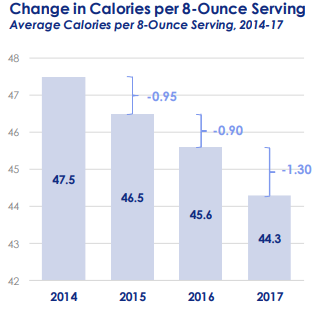
Why isn’t it doing better? The simple answer: sugary drinks sell and are highly profitable.
The report explains the trends:
The report does not give advertising figures.
I’d like to know which products are getting the most marketing dollars. Want to take a guess?
I am ever surprised by the extent to which Trump Administration’s policies directly harm its core supporters. Two recent reports tell the story.
One comes from a group called Tariffs Hurt the Heartland, which has produced an accounting of the losses to businesses in Texas as a result of Republican trade policies—$424 million gone, just in August.
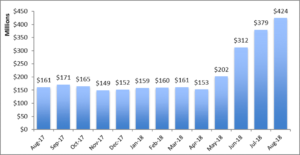
Some of this affects farmers:
Scott Frazier, a south Texas farmer and Secretary-Treasurer of the Texas Farm Bureau, warned that tariffs will have long-term consequences for agriculture by shuttering the foreign markets that farmers in Texas and across the country depend on. One quarter of our agricultural products grown in the U.S. are exported to other countries. The economic well-being of American agriculture depends on maintaining and strengthening our export markets, and farm and ranch families depend on this to survive.
The second report comes from the Brookings Institute. It analyzes the effects of Trump’s trade wars on his base.
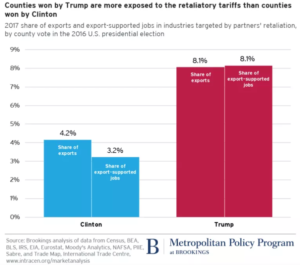
The report comes with a spreadsheet where you can look up the data for yourself.
Trade wars have consequences, in this case for U.S. agriculture, which according to this report accounts for 15% of the retaliatory tariff burden:
The retaliatory tariffs differ by trading partner, but there are some commonly targeted industries. All four markets focused tariffs on agricultural products. Agriculture cuts a very specific geography across the United States, particularly implicating metro areas in California’s Central Valley as well as rural areas and small towns in states like Illinois, Iowa, and Nebraska.
Ouch.
I just got an advance copy of my new book about food company sponsorship of nutrition research and its effects on public health—to be published next week on October 30.
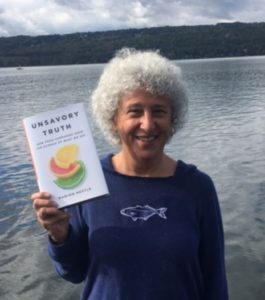
To get a taste (sorry) of the book, here are the first two pages of chapter 4. If you would like to read the Sugar Association’s letter to me and my reply, I’ve included links to them after this excerpt.
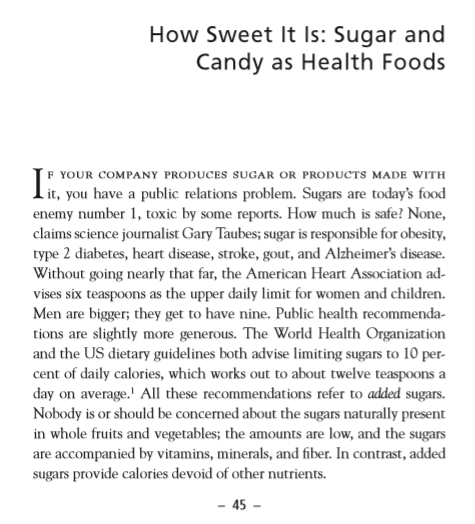
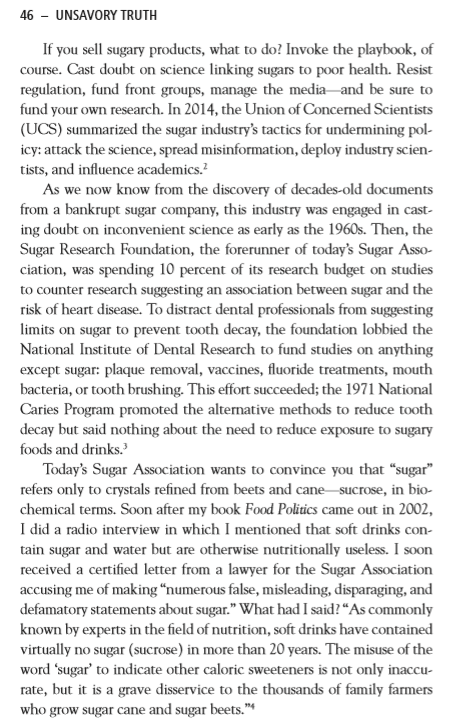
Want to read the rest of the letter and my reply?
Mike Madison. Fruitful Labor: The Ecology, Economy, and Practice of a Family Farm. Chelsea Green 2018 (short at just 164 pages).

Every now and then, Chelsea Green sends me a book this publisher thinks might interest me. And right they are. This book is a perfect example of why I’m so impressed by what Chelsea Green chooses to publish.
Fruitful Labor is a conversational how-to manual for anyone thinking about doing small-scale, sustainable farming and wondering whether it could be fun and provide a decent living. Madison’s optimistic yet realistic outlook makes it clear that both are possible. He raises 200 or so vegetables and fruits on his own farm of 20 acres or so near Sacramento.
The book covers the specifics of what equipment and tools you need and what you need to do to raise animals, take care of the soil, and, yes, make a living. Madison philosophizes about such matters as spacing of trees, what to do about wild animals, water quality, care of tools, the cost of electricity, and other such details.
He provides a copy of his IRS profit-and-loss statement and explains what it means to have enough income.
Dianne and I have never been motivated to be rich in terms of money. We live in a beautiful place, we have many friends, we’re healthy, we have meaningful work, and we have wholesome food to eat and good local wine to drink–what would we want with more money?
Later, he explains the reality:
The increasing price of farmland in this area has far outstripped the rising prices of other assets, most notably labor, to the extent that a young couple starting out today has no possibility of replicating our experience….the price of farmland reflects not only its agricultural value, but also its value as an instrument of financial speculation and a place for a homesite; it is the latter two that primarily drive the price….In this context, our farming system is not sustainable.
This is a thoughtful, useful book, a pleasure to read and an inspiring plea for what used to be understood as agrarian values.
More than ever, we need such values. Thank you Mike Madison, and thanks also to Chelsea Green.
FoodNavigator-USA has collected its recent articles on food industry lawsuits. As it puts it,
There have been hundreds of class action lawsuits directed against food and beverage companies in the past five years, spanning everything from added sugar, ‘natural’ and ‘healthy’ claims, to glyphosate residues, and alkaline water claims. We take a look at some high profile cases, some emerging hot topics from Non GMO claims to a new wave of kombucha lawsuits, and what’s coming up from the FDA, from plant-based ‘milk’ labeling guidance to a fresh look at ‘healthy’ and ‘natural’ labeling.
I’ve organized these into categories.
GMOs
Warnings about chemicals in foods
Compliance with labeling and health claims requirements
And here’s a more recent one from CBS News:
LaCroix ingredients: Lawsuit alleges “all natural” claim is false: LaCroix sparkling water is facing a lawsuit alleging its claims of “all natural” and “100 percent natural” are misleading because…”Testing reveals that LaCroix contains a number of artificial ingredients, including linalool, which is used in cockroach insecticide.”
And here’s one more from CSPI (an October 24 addition):
Addition, December 11